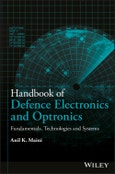Handbook of Defence Electronics and Optronics
Anil K. Maini, Former Director, Laser Science and Technology Centre, India
First complete reference on defence electronics and optronics
Fundamentals, Technologies and Systems
This book provides a complete account of defence electronics and optronics. The content is broadly divided into three categories: topics specific to defence electronics; topics relevant to defence optronics; and topics that have both electronics and optronics counterparts.
The book covers each of the topics in their entirety from fundamentals to advanced concepts, military systems in use and related technologies, thereby leading the reader logically from the operational basics of military systems to involved technologies and battlefield deployment and applications.
Key features:
- Covers fundamentals, operational aspects, involved technologies and application potential of a large cross-section of military systems.
- Discusses emerging technology trends and development and deployment status of next generation military systems wherever applicable in each category of military systems.
- Amply illustrated with approximately 1000 diagrams and photographs and around 30 tables.
- Includes salient features, technologies and deployment aspects of hundreds of military systems, including: military radios; ground and surveillance radars; laser range finder and target designators; night visions devices; EW and EO jammers; laser guided munitions; and military communications equipment and satellites.
Handbook of Defence Electronics and Optronics is an essential guide for graduate students, R&D scientists, engineers engaged in manufacturing defence equipment and professionals handling the operation and maintenance of these systems in the Armed Forces.
Table of Contents
Preface xxi
1 Military Communications 1
1.1 Introduction to Military Communications 1
1.2 Communication Techniques 5
1.3 Communication Transmitters and Receivers 35
1.4 Antennas, Transmission Media and Propagation Modes 52
1.5 Optical Communication 77
1.6 SoftwareÂ-Defined Radio 82
1.7 NetworkÂ-Centric Warfare 87
1.8 C4ISR 89
1.9 Representative Military Communications Equipment 91
Illustrated Glossary 101
Bibliography 111
2 Radar Fundamentals 113
2.1 Introduction to Radar 113
2.2 Basic Radar Functions 118
2.3 Accuracy and Resolution 123
2.4 Radar CrossÂ-Section 129
2.5 Radar Clutter 137
2.6 Radar Range Equation 144
2.7 Radar Waveforms 148
2.8 Radar Transmitters 155
2.9 Radar Receivers 159
2.10 Radar Displays 167
2.11 Radar Antennas 168
2.12 Types of Radar 169
Illustrated Glossary 199
Bibliography 201
3 Military Radars 203
3.1 Military Applications of Radar Systems 203
3.2 Ground (or Area) Surveillance Radar Systems 212
3.3 Air Surveillance Radar Systems 224
3.4 Ground Penetrating Radar Systems 240
3.5 Weapon Locating Radar Systems 253
3.6 FireÂ-Control Radar Systems 265
3.7 SpaceÂ-Based Radar Systems 272
3.8 Police Radar 278
Illustrated Glossary 285
Bibliography 294
4 Satellite Technology 295
4.1 Basic Principles of Orbiting Satellites 295
4.2 Satellite Launch and InÂ-Orbit Operations 317
4.3 Satellite Hardware 341
4.4 Multiple Access Techniques 358
4.5 Satellite Link Design 367
4.6 Networking Concepts 387
Illustrated Glossary 408
Bibliography 417
5 Military Satellites 419
5.1 Military Applications of Satellites 419
5.2 Military Communication Satellites 420
5.3 Military Satellite Communication Systems 421
5.4 Major International Military Communication Satellites 429
5.5 Reconnaissance Satellites 433
5.6 Major International Reconnaissance Satellites 443
5.7 Military Weather Forecasting Satellites 449
5.8 Military Navigation Satellites 450
5.9 Major International Navigation Satellites 454
5.10 The Future of Satellite Navigation Systems 458
5.11 SpaceÂ- Based Weapons 458
Illustrated Glossary 470
Bibliography 473
6 Electronic Warfare 475
6.1 Introduction to Electronic Warfare 475
6.2 Types of Electronic Warfare Systems 476
6.3 Electronic Support Measures 477
6.4 Electronic Countermeasures (ECM) 503
6.5 ElectroÂ-Optic Countermeasures 519
6.6 Infrared Countermeasures 526
6.7 Electronic CounterÂ-Countermeasures 533
6.8 Stealth Technology 535
6.9 Current and Future Trends in Electronic Wafare 542
Illustrated Glossary 544
Bibliography 554
7 Laser Fundamentals 555
7.1 Operational Basics 555
7.2 Laser Characteristics 576
7.3 Laser Parameters 579
7.4 Measurement of Laser Parameters 585
7.5 Laser Beam Diagnostic Equipment 589
7.6 Types of Lasers 592
7.7 SolidÂ-State Lasers 593
7.8 Fibre Lasers 613
7.9 Gas Lasers 621
7.10 Semiconductor Lasers 639
Illustrated Glossary 659
Bibliography 667
8 Laser Electronics 669
8.1 Basic Building Blocks of Laser Electronics 669
8.2 Laser Electronics and Related Technologies 723
8.3 SolidÂ-State Laser Electronics 730
8.4 Gas Laser Electronics 740
8.5 Semiconductor Diode Laser Electronics 758
Illustrated Glossary 775
Bibliography 781
9 Photo Sensors and Related Devices 783
9.1 Classification of Photo Sensors 783
9.2 Radiometry and Photometry 785
9.3 Characteristic Parameters 786
9.4 Photoconductors 793
9.5 Photo Diodes 797
9.6 Solar Cells 806
9.7 Photo Transistors 808
9.8 Photo FET, Photo SCR and Photo TRIAC 810
9.9 Image Sensors 812
9.10 Photo Emissive Sensors 818
9.11 Thermal Sensors 820
9.12 LightÂ-Emitting Diodes (LEDs) 824
9.13 Displays 829
9.14 Night Vision Technologies 838
Illustrated Glossary 856
Bibliography 862
10 Military Laser Systems 865
10.1 Military Applications of Lasers 865
10.2 Laser Aiming Devices 868
10.3 Laser Range Finders (LRF) 869
10.4 Laser Target Designators 884
10.5 Laser Proximity Sensors 901
10.6 LaserÂ-Based Detection of ElectroÂ-Optic Targets 904
10.7 Laser Bathymetry Sensors 907
10.8 LADAR Sensors 909
10.9 LaserÂ-Based Gyroscopic Sensors 912
10.10 LIDAR For Detection of Chemical and Biological Warfare Agents 920
10.11 LaserÂ-Based Detection of Explosive Agents 924
Illustrated Glossary 926
Bibliography 931
11 PrecisionÂ-Guided Munitions 933
11.1 Introduction 933
11.2 Types of Guided Weapons 934
11.3 Guidance Techniques 939
11.4 LaserÂ-Guided Munitions 947
11.5 Major LaserÂ-Guided Weapon Systems 959
11.6 Testing LaserÂ-Guided Munitions 964
11.7 InfraredÂ-Guided Weapons 968
11.8 Major InfraredÂ-Guided Weapon Systems 983
11.9 Testing InfraredÂ-Guided Weapons 991
11.10 RadarÂ-Guided Weapons 994
11.11 Major RadarÂ-Guided Weapon Systems 999
11.12 GPS/INSÂ-Guided Weapons 1004
Illustrated Glossary 1006
Bibliography 1011
12 Directed Energy Weapons 1013
12.1 DirectedÂ-Energy Weapons (DEWs) 1013
12.2 Types of DEWs 1015
12.3 Particle Beam Weapons 1016
12.4 HighÂ-Power Microwave (HPM) Weapons 1025
12.5 DirectedÂ-Energy Laser Systems 1051
12.6 LessÂ-Lethal Laser Dazzlers 1052
12.7 HighÂ-Power Lasers for Ordnance Disposal 1061
12.8 HighÂ-Power DirectedÂ-Energy Laser Weapons 1065
12.9 HighÂ-Power Laser Sources 1071
12.10 BeamÂ-Control Technologies 1086
12.11 Laser Propagation Effects 1087
12.12 Lethality 1091
12.13 Representative DirectedÂ-Energy Laser Weapon Systems 1092
12.14 LaserÂ-Induced Plasma Channel (LIPC) Weapons 1098
Illustrated Glossary 1098
Bibliography 1105
Index 1107








